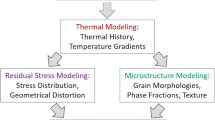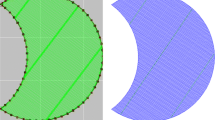Abstract
Physics-based modeling of metal additive manufacturing (AM) processes is computationally challenging due to the very fine meshing required in both time and space. State-of-the-art numerical models that offer great insight into the process have been developed, but they require powerful computational resources and weeks of processing time. Thus, it is often more time-effective to fabricate multiple builds within the time it takes to complete one simulation prediction, further reinforcing the current trial-and-error approach to optimizing the build parameters. This study presents a simplified approach to the transient thermal modeling of the AM process. The numerical model is designed to run on a moderate laptop or desktop computer, without use of parallel processing. The method described in this study uses a unique approach to node creation which leverages the simplicity of the finite difference method to provide predictions in less time than it takes to build the part. Coarse meshing in both time and space along with simplifying assumptions about the solidification process are used in this numerical approach. Model predictions track well with experimental measurements. This approach is being developed for use in an industrial setting to inform deposition parameters based on a desired thermal profile.






Similar content being viewed by others
References
H. Krueger, Engineering 3, 585 (2017).
T. DebRoy, H.L. Wei, J.S. Zuback, T. Mukherjee, J.W. Elmer, J.O. Milewski, A.M. Beese, A. Wilson-Heid, A. De, and W. Zhang, Prog. Mater Sci. 92, 112 (2018).
S.A.M. Tofail, E.P. Koumoulos, A. Bandyopadhyay, S. Bose, L. O’Donoghue, and C. Charitidis, Mater. Today 21, 22 (2017).
W.E. Frazier, J. Mater. Eng. Perform. 23, 1979 (2014).
T. Stockman, C. Knapp, K. Henderson, J.S. Carpenter, and J. Schneider, JOM 70, 1835 (2018).
L. Wang, S. Felicelli, Y. Gooroochurn, P. Wang, and M. Horstemeyer, Mater. Sci. Eng. A 474, 148 (2008).
T. Craeghs, F. Bechmann, S. Berumen, and J.P. Kruth, Phys. Procedia 5, 505 (2010).
J.E. Craig, T. Wakeman, R. Grylls, and J. Bullen, Sensors, Sampling, and Simulation for Process Control (Hoboken: Wiley, 2011), p. 103.
M. Khanzadeh, S. Chowdhury, M. Marufuzzaman, M.A. Tschopp, and L. Bian, Sens. Sampl. Simul. Process Control 47, 69 (2018).
A. Bandyopadhyay and K.D. Traxel, Addit. Manuf. 22, 758 (2018).
A. Peralta, M.P. Enright, M. Megahed, J. Gong, M. Roybal, and J. Craig, Integr. Mater. Manuf. Innov. 5, 8 (2016).
S.K. Everton, M. Hirsch, P. Stravroulakis, R.K. Leach, and A.T. Clare, Mater. Des. 95, 431 (2016).
D. Rosenthal, Trans. ASME 68, 849 (1946).
T.W. Eager and N.S. Tsai, Weld. J. 62, 346 (1983).
J. Ding, P. Colegrove, J. Mehnen, S. Williams, F. Wang, and P.S. Almeida, Int. J. Adv. Manuf. Technol. 70, 227 (2014).
J. Irwin and P. Michaleris, J. Manuf. Sci. Eng. 138, 111004 (2016).
P. Foteinopoulos, A. Papacharalampopoulos, and P. Stravropoulos, J. Manuf. Sci. Technol. 20, 66 (2018).
S. Tadano, T. Hino, and Y. Nakastani, J. Mater. Process. Technol. 257, 163 (2018).
H. Zhao, G. Zhang, Z. Yin, and L. Wu, J. Mater. Process. Technol. 212, 276 (2012).
M. Chiumenti, M. Cervera, A. Salmi, C. Agelet de Saracibar, N. Dialami, and K. Matsui, Comput. Methods Appl. Mech. Eng. 199, 2343 (2010).
P. Prabhakar, W.J. Sames, R. Dehoff, and S.S. Babu, Addit. Manuf. 7, 83 (2015).
J. Wu, L. Wang, and X. An, Optik 137, 65 (2017).
P. Machaleris, Finite Elem. Anal. Des. 86, 51 (2014).
J. Ding, P. Colegrove, J. Mehnen, S. Ganguly, P.M.S. Almeida, F. Wang, and S. Williams, Comput. Mater. Sci. 50, 3315 (2011).
J. Crank and P. Nicolson, Proc. Camb. Phil. Soc. 43, 50 (1947).
“Carpenter Invar 36® Alloy, Cold Drawn Bars” Matweb, http://www.matweb.com/search/datasheet.aspx?matguid=b6fb00b235f0442da4d31a0cd04671c9&ckck=1. Accessed January 2018.
Y. Jaluria, Computational Heat Transfer, 2nd ed. (New York: Taylor & Francis, 2003), pp. 37–82.
T. Bergman, F. Incropera, D. DeWitt, and A. Lavine, Fundamentals of Heat and Mass Transfer, 6th ed. (Hoboken: Wiley, 2007), pp. 8–9.
T. Stockman, Los Alamos National Laboratory, Los Alamos, NM, unpublished research (2018).
R. Kozakov, H. Schöpp, H. Gött, A. Sperl, G. Wilhelm, and D. Uhrlandt, J. Phys. D Appl. Phys. 46, 475501 (2013).
Acknowledgements
T.S., B.W., and J.A.S. acknowledge funding provided in part by a Navy STTR Phase II with Oregon Institute of Technology/Keystone Synergistic Enterprises, Inc., Contract #KSE17035-OIT and a NASA STTR Phase II with Keystone Synergistic Enterprises, Inc., Grant NNX15CM68P. Additional funding is provided (J.S.C., T.S.) by the Los Alamos National Laboratory, an affirmative action equal opportunity employer, operated by Los Alamos National Security, LLC, for the National Nuclear Security Administration of the US Department of Energy under Contract DE-AC5206NA25396.
Author information
Authors and Affiliations
Corresponding author
Rights and permissions
About this article
Cite this article
Stockman, T., Schneider, J.A., Walker, B. et al. A 3D Finite Difference Thermal Model Tailored for Additive Manufacturing. JOM 71, 1117–1126 (2019). https://doi.org/10.1007/s11837-019-03338-6
Received:
Accepted:
Published:
Issue Date:
DOI: https://doi.org/10.1007/s11837-019-03338-6




